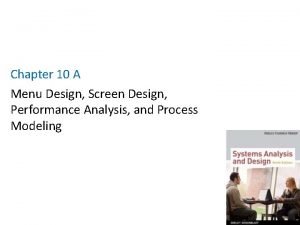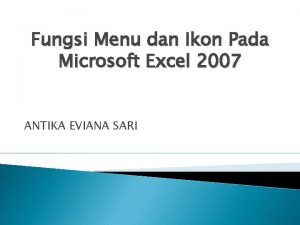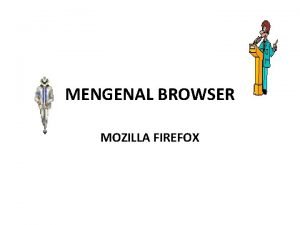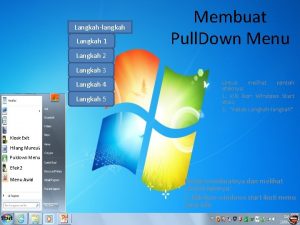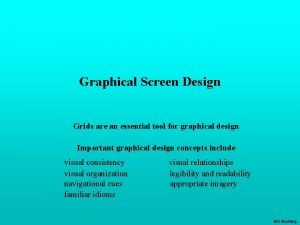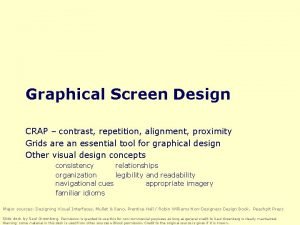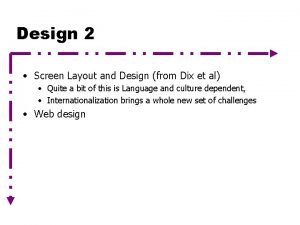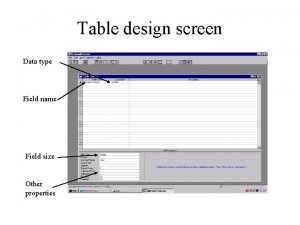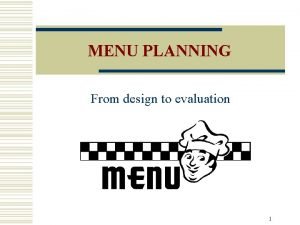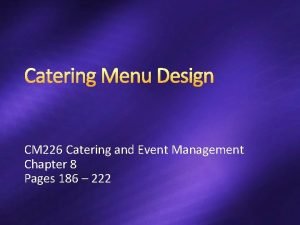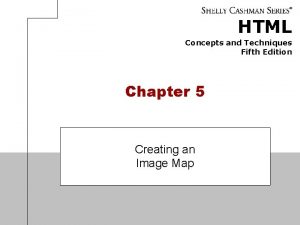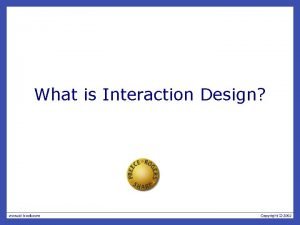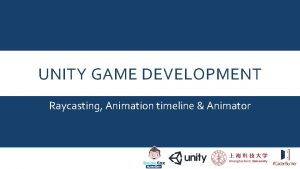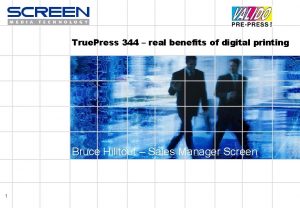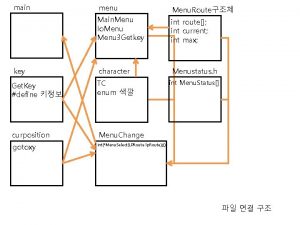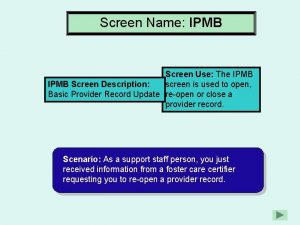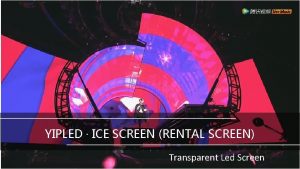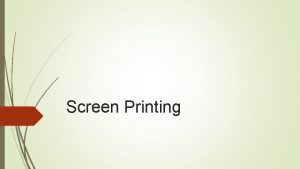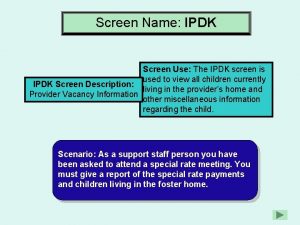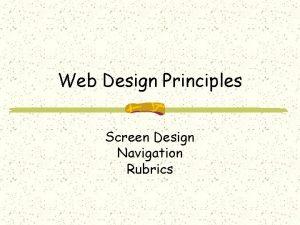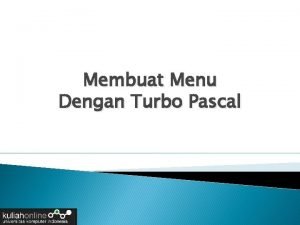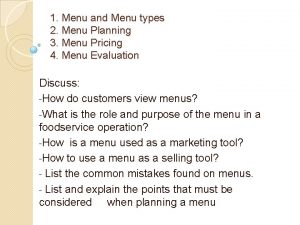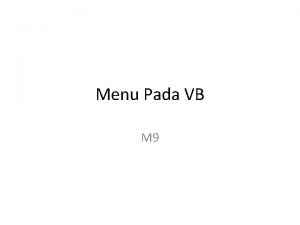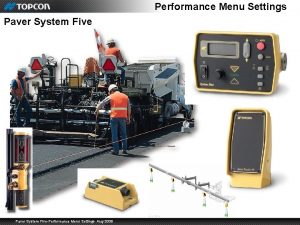Chapter 10 A Menu Design Screen Design Performance





























- Slides: 29

Chapter 10 A Menu Design, Screen Design, Performance Analysis, and Process Modeling

Chapter Objectives • Provide a checklist of issues to consider when selecting a system architecture • Describe servers, server-based processing, clients, and client-based processing • Explain client/server architecture, including tiers, cost-benefit issues, and performance • Compare in-house e-commerce development with packaged solutions 2

Chapter Objectives • Explain the difference between online and batch processing • Define network topology, including hierarchical, bus, ring, and star models 3

Chapter Objectives • Explain network protocols and licensing issues • Describe wireless networking, including wireless standards, topologies, and trends • Describe the system design specification 4

Introduction • An effective system combines elements into an architecture, or design, that is flexible, cost-effective, technically sound, and able to support the information needs of the business • System architecture translates the logical design of an information system into a physical structure that includes hardware, software, network support, and processing methods 5

System Architecture Checklist • Enterprise Resource Planning (ERP) – The objective of ERP is to establish a companywide strategy for using IT resources – Supply chain management (SCM) • Initial Cost and TCO – During the final design stage, you make decisions that will have a major impact on the initial costs and TCO for the new system – You should review all previous cost estimates 6

System Architecture Checklist • Scalability – Scalability, also called extensibility, refers to a system’s ability to expand, change or downsize easily to meet the changing need of a business enterprise – Especially important in implementing systems that are volume-rated, such as transaction processing systems 7

System Architecture Checklist • Web Integration – An information system includes applications – Web-centric architecture – Avoids many of the connectivity and compatibility problems that typically arise – E-marketplaces 8

System Architecture Checklist • Legacy System Interface Requirements – The new system might have to interface with one or more legacy systems – Interfacing a new system with a legacy system involves analysis of data formats and compatibility – The analyst must know if the new application eventually will replace the legacy system 9

System Architecture Checklist • Processing Options – In planning the architecture, designers also must consider how the system will process data - online or in batches – Provision must be made for backup and speedy recovery in the event of system failure 10

System Architecture Checklist • Security Issues – Security threats and defenses are a major concern to a systems analyst – The analyst must consider security issues that relate to system design specifications – Web-based systems introduce additional security concerns 11

Planning the Architecture • Servers – – Server Clients Mainframe architecture Server-based processing 12

Planning the Architecture • Clients – As PC technology exploded in the mid-1980 s and 1990 s, powerful microcomputers quickly appeared on corporate desktops – Users found that they could run their own word processing, spreadsheet, and database applications – Companies linked the stand-alone computers into networks 13

Planning the Architecture • Clients – Stand-Alone Computing – Local and wide area networks – Client-based processing 14

Client/Server Architecture • Overview 15

Client/Server Architecture • Client/Server Design Styles 16

Client/Server Architecture • Client/Server Performance Issues – In contrast to the centralized system, a client/server design separates applications and data – Distributed database management system (DDBMS) – The system is scalable, so new data sites can be added without reworking the system design – The system is less likely to experience catastrophic failure 17

Internet-Based Architecture • Corporate Portals – A corporate portal can provide access for customers, employees, suppliers, and the public • Cloud Computing – Effectively eliminates compatibility issues – Scaling on demand – Requires significantly more bandwidth 18

Processing Methods • Online Processing – Because it is interactive, online processing avoids delays and allows a constant dialog between the user and the system – Online processing also can be used with fileoriented systems 19

Processing Methods • Batch Processing – The IT operations group can run batch programs on a predetermined schedule, without user involvement, during regular business hours, at night, or on weekends – Require significantly fewer network resources than online systems 20

Processing Methods • Combined Online and Batch Processing 21

Network Models • The OSI Reference Model – The OSI model consists of seven layers – Each layer performs a specific function – Offers a set of design standards 22

Network Models • Network Protocols – In all cases, the network must use a protocol – Transmission Control Protocol/Internet Protocol (TCP/IP) – File Transfer Protocol (FTP) 23

Systems Design Completion • System Design Specification – A typical system design specification uses a structure similar to the following: 1. 2. 3. 4. 5. 6. Management summary System components System environment Implementation requirements Time and cost estimates Additional material 24

Systems Design Completion • User Approval – Users must review and approve the interface design, report and menu designs, data entry screens, source documents, and other areas of the system that affect them – Other IT department members also need to review the system design specification – When the system design specification is complete, you distribute the document to a target group of users, IT department personnel, and company management 25

Systems Design Completion • Presentations – The first presentation is to the systems analysts, programmers, and technical support staff members – Your next presentation is to department managers and users from departments affected by the system – The final presentation is for company management – Management might reach one of three decisions: proceed with systems development, perform additional work on the systems design phase, or terminate the project 26

Chapter Summary • An information system combines hardware, software, data, procedures, and people into a system architecture • The analyst must consider enterprise resource planning, initial cost and TCO, scalability, Web integration, legacy interface requirements, processing options, and security issues • An architecture requires servers and clients 27

Chapter Summary • Compared to file server designs, client/server systems are more scalable and flexible • In implementing a design, an analyst should consider e-commerce strategies, the availability of packaged solutions, and corporate portals, which are entrances to a multifunction Web site • The primary processing methods are online and batch processing 28

Chapter Summary • Networks allow the sharing of hardware, software, and data resources in order to reduce expenses and provide more capability to users • The way a network is configured is called the network topology • The system design specification presents the complete systems design for an information system 29
 Menu screen design
Menu screen design Screen small screen offscreen
Screen small screen offscreen Pengertian perencanaan menu
Pengertian perencanaan menu Fungsi menu excel
Fungsi menu excel Meal order atau menu composition
Meal order atau menu composition Mozilla firefox icon
Mozilla firefox icon Menu pull down
Menu pull down Screen design and layout in hci
Screen design and layout in hci Graphical screen design
Graphical screen design Crap design
Crap design Screen layout design
Screen layout design Name the two parts of table design screen
Name the two parts of table design screen Basic principle of input design
Basic principle of input design Chapter 11 performance appraisal - (pdf)
Chapter 11 performance appraisal - (pdf) Performance levels
Performance levels Jcids process
Jcids process Basic rules of menu planning
Basic rules of menu planning Event menu design
Event menu design Difference between a la carte and table d'hote menu
Difference between a la carte and table d'hote menu Fifth chapter menu
Fifth chapter menu How do these screen objects afford?
How do these screen objects afford? Screen based control
Screen based control Screen-reader-response
Screen-reader-response Animation event unity
Animation event unity Screen direction adalah
Screen direction adalah Dic
Dic Pers 43 aviation screen boards
Pers 43 aviation screen boards Screen truepress 344
Screen truepress 344 Conclusion of touch screen technology
Conclusion of touch screen technology Puzzle lock screen
Puzzle lock screen
